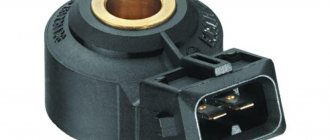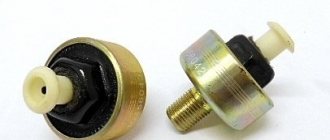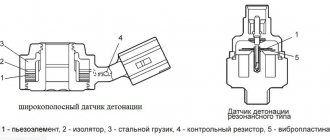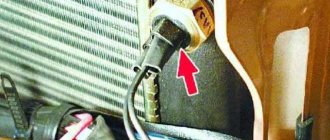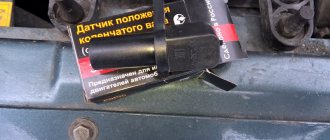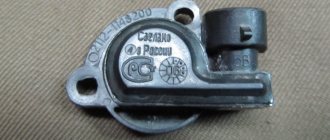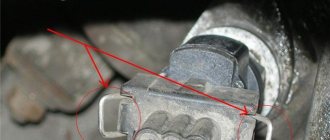Purpose of the knock sensor
DD is involved in the formation of the fuel mixture, and also participates in setting the ignition timing (IAF). If there is any noise in the internal combustion engine, the sensor transmits readings to the electronic engine control unit (ECU), which in turn, according to the sensor data, levels out the operation of the internal combustion engine.
The sensor itself is a round element with a plug and a hole in the center. Inside there are threads that allow you to find resonance and a piezoelectric element. When detonation occurs, the threads begin to vibrate and are converted into an impulse, which is transmitted to the ECU.
When the ECU receives readings based on voltage, it sets the ignition timing. This is necessary for more correct combustion of fuel in the cylinders, thereby ensuring more correct and smooth operation of the engine. This process is continuous throughout the engine operation.
The main purpose of DD is to extend the service life of the engine.
The knock sensor cannot be repaired and if it malfunctions, it only needs to be replaced with a new sensor. Fortunately, its price is not high, and there are also enough non-original, high-quality analogues on the market, which are listed below in the table. There are no differences between DD in engines with 8 and 16 valves; the sensors for both types of engines are exactly the same.
Below is a table with the article number and cost of the knock sensor for the Lada Priora
| Manufacturer | vendor code | Price (rubles) |
| LADA (original) | 21123855020 | 200-400 |
| Samara, 2112 | 3855020 | 180-250 |
| ERA | 550489 | 300-400 |
| "Road map" | 21123855020 | 250-360 |
| Decaro | 2112-3855020 | 380-500 |
| Fenox | SD10100O7 | 200-400 |
Operating principle of the sensor
Its design is simple - the sensor is based on a plate with a piezoelectric effect. When there is a mechanical impact on it (impact, as happens when a motor detonates), the plate begins to generate electricity. And the stronger the impact, the more current the sensor will transmit to the engine control system. The magnitude of the current corresponds to a certain level of detonation, and based on these readings, the computer executes an embedded algorithm aimed at eliminating its causes.
A knock sensor error is a consequence of the computer receiving incorrect data, resulting in instability in engine operation.
As statistics show, such a malfunction most often occurs with domestically produced cars - quite often the problem with DD is observed on a VAZ 2112 with a 16-valve engine - for this reason, car owners are recommended to always have a spare VAZ knock sensor on hand, since its cost is within 200- 300 rubles. Foreign cars, in most cases, are equipped with sensors whose service life exceeds the service life of the car itself.
DD location
The sensor is located at the front of the cylinder block and is mounted on a stud or M6 bolt between the second and third cylinders. This location was chosen to more clearly capture all engine knocks.
It is difficult to see the sensor on engines with 16-valve engines, since access to it is blocked by the intake receiver. On 8-valve engines, access to the DD is open and will not be difficult.
Causes of sensor malfunction and ways to check it
The knock sensor on cars rarely fails, including the Priora. However, VAZ-2170 owners can often detect a DD malfunction error. And the reasons for its occurrence may be the following factors:
- Damage to the wiring that connects the sensor to the ECU.
During operation of the car, damage to the insulation may occur, which will ultimately affect the signal level. A normally operating sensor produces a signal from 0.6 to 1.2V. - Oxidation of contacts.
The device is located on the cylinder block and is exposed not only to moisture, but also to aggressive substances in the form of engine oil. Although the sensor contact is sealed, a connection failure cannot be ruled out, which leads to oxidation of the contacts in the sensor or chip. If the wire on the DD is in good condition, then you need to make sure that the contacts in the chip and on the sensor connector are intact. - Violation of the integrity of the body. It should not have cracks or other defects.
- Damage to internal elements.
This happens extremely rarely, and you can verify the suitability of the device by testing. The piezoceramic element or resistor may fail. To do this, you will need to perform a sensor test. - The connection between the sensor and the cylinder head is not reliable enough.
It is recommended to pay attention to this point to all owners of Priora cars whose BC displays error P0326 . The device is fixed with a bolt that has a shortened thread. This thread does not rest against the block with its end part, therefore vibrations from the block with a normally operating motor are not enough to generate the minimum permissible signal of 0.6V. As a rule, a sensor fixed with such a bolt produces a low voltage of 0.3-0.5V, which is why error P0326 occurs. The problem can be corrected by replacing the bolt with a stud of the appropriate size.
Having considered the main symptoms of a malfunction of the knock sensor on a Priora, you should resort to checking its serviceability. To do this, you need to arm yourself with a multimeter. The method for checking the device is quite simple, and it is much more difficult to remove the sensor from the car than to check its suitability. The check is performed as follows:
- Vehicle-mounted sensor. You can check the device without removing it, which is especially important for Priora cars with 16-valve engines, where access to the device is limited. To check the sensor, you must perform the following steps: get close to the sensor in order to be able to strike on or near it. We ask the assistant to start the engine, after which we strike the sensor with a metal object. As a result, the sound of the engine should change, which indicates that the ECU has set the ignition later. If such changes can be traced, it means that the device is working properly and is suitable for use. This also indicates that the sensor circuit is working properly.
- Checking the voltage on the sensor removed from the car. Connect the multimeter probes to its terminals and switch the device to the 200 mV voltage measurement mode. This is necessary in order to fix the voltage on the device. Next, lightly hit the metal part of the sensor with a steel object (or press the metal part with your fingers), and observe the readings. Their changes indicate the suitability of the device.
- Checking resistance. A working DD on Priora and other VAZ models has a resistance that is equal to infinity, which is quite normal, since when not working the piezoelements are not connected to the contact washers. We connect the device to the DD terminals, setting the measurement mode to MOhm, and take measurements. In the non-working position, the value will tend to infinity (on device 1), and if you start to influence the sensor, squeezing it or hitting it with a metal key, the resistance will change and amount to 1-6 MOhm. It is important to understand that sensors for other cars have different resistance values.
- Check the condition of the wires and contacts of the chip. It is checked visually, and if damage to the insulation is detected, the chip must be replaced.
- Checking the integrity of the circuit. To do this, you need to arm yourself with a multimeter with a continuity mode, and test the wires from the chip to the terminals on the ECU. The pinout diagram for the knock sensor on the Priora will help with this.
Knock sensor pinout diagram
The above presented pinout diagram for the Priora knock sensor is appropriate for January and Bosch brand controllers. If the wires are not damaged, and error P0325 is displayed on the BC, then this indicates a failure of the resistor. Some craftsmen eliminate such a breakdown by soldering a resistor of the appropriate size between the wires in front of the chip. However, this is not recommended, and it is much easier and more reliable to buy a new sensor and replace it. Moreover, the cost of the product is 250-800 rubles (depending on the manufacturer).
This is interesting! If checking the sensor and wires shows that there are no defects, but the error message on the BC about a device malfunction continues to light up, then you should resort to replacing the fastening element, that is, replace the bolt with a stud with an extended thread. How to do this correctly, read in the next section.
Symptoms of a problem
It is quite difficult to immediately determine the failure of the motor control; you need to feel and know your car well in order to quickly feel the malfunction. The “Check Engiene” warning light does not light up in the event of a malfunction, but an error with the name “Low signal level of the knock sensor” is stored in the ECU; this error is numbered 0327.
Symptoms:
- Increased fuel consumption is quite difficult to notice quickly;
- Increased engine vibrations;
- More sluggish and longer acceleration of the car;
Purpose
The knock sensor is a small device that is installed on injection engines. In case of uncontrolled combustion of the fuel mixture, regardless of the cause, the device automatically changes the ignition timing of the fuel mixture.
The importance of this device for engine safety is difficult to overestimate. Even if the car is fully tuned and its main parts are made without defects, then no one is safe from refueling with low-quality fuel.
As a result of using low-quality fuel, the working parts of the piston group may fail when the vehicle's mileage is less than 10,000 km. This device allows you to protect the internal combustion engine from the harmful effects of explosive gasoline combustion.
Sensor check
Once you suspect that there is something wrong with your car, there are symptoms similar to a breakdown of the DD, then it needs to be checked. To check the sensor, you need an electronic multimeter and a screwdriver.
On the multimeter we set the minimum constant voltage values (200 mV), since the voltage pulse from the knock sensor is very small and practically does not exceed 150 mV.
Next, connect the probes to the sensor (polarity does not matter).
Use a metal object (screwdriver) to hit the metal part of the sensor. Values not exceeding 200 mV should appear on the multimeter screen.
If no values appear on the screen, then the DD is faulty and must be replaced.
Additional comments for troubleshooting P0328
When diagnosing the P0328 code, it is very important to follow the diagnostic protocol to ensure all checks and repairs are performed correctly.
To make a proper diagnosis, a mechanic will need a professional scanner that can not only read stored error codes, but can also view data from various sensors, such as fuel pressure and engine coolant temperature, in real time.
Need help with error code P0328?
The company - CarChek, offers a service - on-site computer diagnostics; specialists from our company will come to your home or office to diagnose and identify problems with your car. Find out the cost and sign up for on-site computer diagnostics or contact a consultant by phone
We only find out where the knock sensor is located when we encounter problems with it. And before we talk about its location, it is worth understanding what this element is and what it is needed for. Let's start with this!
Replacement
Replacing the knock sensor on a Priora is quite easy to do yourself. This work will not cause any difficulties if you use the instructions described below.
First you need to prepare the tool:
- Ratchet with 13mm head;
- 10mm wrench;
- Wire brush;
- Screwdriver;
Replacement process
Replacing on a 16-valve engine is a little more complicated than on an 8-valve engine, so let’s consider the work using the example of an engine with 16 valves.
- We remove the negative mark from the battery, since the work will be performed on the electrical equipment of the car.
- We remove the air filter box by unscrewing the clamp from the mass flow sensor and removing the connector from it.
Source
Required Tools
Table - Tools and materials required to replace the knock sensor
| Name | Note |
| Socket wrench or socket | “at 10”, “at 13″”, “at 19” |
| Vorotok | With ratchet |
| Torque wrench | To check the tightening of the knock sensor fastening |
| Rags and wire brush | To clean dirt |
| Penetrating lubricant | To release stuck threaded fastenings of the crankcase protection |
Work should be carried out with access from the bottom of the car. Therefore, it is recommended to proceed with independent replacement if there is an inspection hole or overpass.
Checking the functionality of the sensor
Do not rush to throw away the old sensor - first you should check its functionality. Often the problem lies in faulty wiring, in which case replacing the sensor will not help.
To test the knock sensor, you should connect it to a multimeter, setting the latter to test DC current. When hitting the sensor, the multimeter should show a voltage of about 15–30 mV. The more intensely you hit it, the more voltage it should generate. If the multimeter shows nothing when hitting the sensor, then it definitely needs to be replaced.
If you notice even a slight manifestation of a sensor malfunction, it is necessary to diagnose the vehicle. But often, when a single error occurs, the malfunction icon on the dashboard is constantly lit, although there are no other signs of a sensor malfunction - in this case, it is enough to reset the computer errors.
We will answer your questions for FREE regarding deprivation of rights, road accidents, insurance compensation, driving into the oncoming lane, etc. Daily from 9.00 to 21.00
Moscow and Moscow region
St. Petersburg and Leningrad region
Free call within Russia 8-800-350-23-69 ext.418
High signal level - warning codes
Many motorists have encountered the problem of various knock regulator warning signals. One of them may be P0328 - high signal level of the knock sensor . It can cause not only a malfunction of the device itself, but also, for example, too noisy operation of the engine. The best solution to the problem is to contact a service station so that they can diagnose the car, in particular, the element itself.
In addition, there is another signal that the driver can receive from the system - 0327, this code means a low level of the detonation signal. As a rule, it occurs in several cases - either after a long descent with the gear engaged, or in a situation when replacing the sensor is already necessary. In any case, you will either have to check its serviceability on your own; for this it is better to dismantle it and connect it to special equipment, or do this with the help of specialists.
Knock sensor malfunction during operation
To identify malfunctions in the knock sensor, you need to know where it is located in the power compartment of the car. Its location is not far from the oil dipstick at the top of the cylinder block.
Sometimes the defect can be eliminated by simply tightening or loosening the fastening of the product to the motor; the tightening force should be within 20 Nm. It is better to control the tightening force of this type with a special torque wrench. If the adjustment does not have a positive effect, it is necessary to check the VAZ 2110 knock sensor and then replace it with a new product.
The search for faults in the knock sensor must be carried out on a special stand, which is equipped at service stations or repair plants. At home, you can try to repair the VAZ 2110 knock sensor if you have basic concepts in electrical engineering and the car enthusiast can use a tester or similar device with millivoltmeter and megohmmeter scales.
The procedure for determining a malfunction of the knock sensor is as follows:
- Before checking the knock sensor, it must be removed from the power unit. To do this, you need to press the latch and disconnect it from the contact block.
- Unscrew the fastening nut and dismantle the product by removing it from the stud.
- To diagnose a removed device, you need to power it to the terminals of the multivoltmeter, setting the minimum measurement limit.
Important: you should know that for a knock sensor with one contact, the black wire, which is associated with the negative contact, is connected to the mounting bolt socket, and the positive red wire must be connected to the signal contact in the shoe connector
Where is the knock and fuel level sensor located on Lada Priora, signs of malfunction and replacement
How to replace hydraulic compensators on a Lada Priora 16 valves
The Lada Priora engine is controlled by an electronic engine control system (ECM), which includes a controller and a large number of reading and monitoring devices. The article discusses the Priora fuel sensor and knock sensor, their purpose, location, diagnostics and replacement.
Purpose and location of the knock sensor
During explosive self-ignition in the combustion chamber of the fuel assembly, engine detonation appears. To monitor the occurrence of engine vibrations, a knock sensor (DS) is designed (video author – StarsAutoCom).
The DD is a plastic case, inside of which there is a sensitive piezoceramic disk element that generates an electrical impulse under mechanical influence from the resulting vibrations, and transmits information to the ECU controller. The detonation device is located on the front side of the cylinder block under the intake module.
Typical faults
If the Lada Priora DD is faulty, the computer will display an error code - 0327. This error is the main reason why the device is changed.
Possible malfunctions:
- broken wires;
- damage to the connector with wires;
- failure of the device itself.
The reasons why the power unit detonates may be different. Therefore, to make sure that the cause of detonation is the DD, it must be removed and checked.
How to check and change?
To provide access to the knock sensor, the car should be placed on a lift.
To remove the device, you need to do the following:
- Turn off the power to the car by disconnecting the negative terminal from the battery.
- Next you need to remove the engine protection.
- Having found the DD, you need to press the metal clamp, thanks to which the connector with wires from the controller is held, and disconnect the connector.
- Using a key set to “13”, you need to loosen the bolt securing the device and you can remove the DD.
Photo gallery “Replacing the knock regulator on a Lada Priora”
The knock sensor is checked using a multimeter, setting it to voltage measurement mode. Accurate diagnostics can only be carried out on a special stand.
If the device is faulty, it cannot be repaired; it must be replaced. Installation of a new device is carried out in the reverse order of dismantling.
Purpose and location of FLS
The FLS is located in the fuel module, which also includes a fuel pump and fuel filter.
Its main purpose is to monitor the fuel level in the gas tank.
The design of the device includes:
- float;
- dielectric plate with a located rheostat;
- the rod on which the contact slider is located.
Typical faults
If the instrument panel displays incorrect information about the amount of fuel remaining, the reason may be:
- mechanical damage to the gas tank housing;
- float failure;
- electrical faults;
- disruption in the power supply chain;
- FLS malfunction.
To determine the cause, you need to conduct a diagnosis.
How to check and change?
To change the FLS on a Priora, you need to remove the fuel module.
To do this you need to do the following:
- First we remove the rear seat.
- Then unscrew the two screws and remove the hatch cover.
- At the top of the module, disconnect the connector with wires.
- Next, by pressing the latches, the tubes through which gasoline is supplied and the tips of the tee are disconnected.
- Then we unscrew the fastening nuts, remove the wire that goes to ground, and the spring washers.
- The next step is to remove the pressure plate and module.
- After dismantling the module, the wire connector is disconnected from the FLS.
- After installing the new device, assembly is carried out in the reverse order.
When installing a new sensor, you should pay attention to ensure that the rubber seal and plastic ring spacer are installed correctly. https://www.youtube.com/embed/cAOV8QE4xVk
How to change a knock sensor
The knock sensor for VAZ 2110, 2112 and 21214 with a fuel injection system is located in the front of the engine. If the engine has 8 valves, then the sensor is installed in the area of cylinder 4, if there are 16 valves, then between cylinders 2 and 3. On Grant, Priora and Kalina cars it is also located on the engine block between the cylinders.
Replacing it will take no more than 10-15 minutes:
- Unscrew the bolt holding it to the engine block.
- Disconnect the sensor from the terminal block. Remove the sensor and replace it with a working one.
- When installing a new sensor, carefully tighten the mounting bolt - unstable contact with the engine body will lead to errors in the operation of the motor.
The danger of detonation effect on a car and the reasons for its occurrence
Detonation loads are dangerous for any internal combustion engine, and that is why all manufacturers of modern cars equip units with special sensors. Such devices do not exclude the possibility of a process occurring, but warn of its occurrence, which allows the controller to quickly resort to eliminating the problem.
To appreciate the danger of such a process, which is called internal combustion engine detonation, you should look at the photo below.
They depict engine parts that were removed during repair work. The piston and valve suffered such severe destruction precisely because of spontaneous ignition of the fuel in the combustion chambers. The piston and valve are not the only parts that experience accelerated wear during detonation. Because of this phenomenon, other parts, such as the crankshaft and crank mechanism, also experience strong loads.
The causes of engine detonation loads are the following factors:
- Fuel octane number mismatch. If the manufacturer recommends using A-95 gasoline, then using low-octane fuel is strictly contraindicated. Detonation, which occurs due to fuel mismatch, contributes to the formation of carbon deposits, which provokes the development of glow ignition. As a result, after turning off the ignition, the engine continues to function, which is manifested due to the ignition of the fuel assembly from the hot electrodes of the spark plug.
- Operating conditions and driving habits. Very often, engine detonation occurs among inexperienced drivers when upshifting occurs at too low a vehicle speed and with insufficient crankshaft revolutions. It is important to switch to the next gear when the engine speed on the tachometer is between 2.5-3 thousand rpm. If you switch to a higher gear without first accelerating the car, it is possible that a characteristic metallic knock will occur in the area of the engine compartment. This knock is engine detonation. Such detonation is called permissible, and when it occurs, it does not last long.
- Design features of the engine - cars that are equipped with turbocharging are especially susceptible to the development of a negative phenomenon. This effect often occurs if the car is fueled with low-octane fuel. This also includes factors such as the shape of the combustion chamber and tuning (boosting) the internal combustion engine.
- Incorrect setting of the ignition timing angle. However, this phenomenon is more common on carburetor engines, and on an injector it can occur, among other things, due to a malfunction of the knock sensor. If the ignition is too early, the fuel will ignite much earlier than the piston reaches top dead center.
- A high degree of compression in the cylinders often occurs when the engine cylinders are heavily coked. The more carbon deposits on the cylinder walls, the higher the likelihood of detonation loads developing.
- Lean fuel assembly. If a mixture with a low amount of fuel is supplied to the combustion chamber, the high temperature of the spark plug electrodes contributes to detonation. A small amount of gasoline and a large volume of air leads to the development of oxidative reactions that respond to increased temperature. This reason is typical for injection engines, and usually appears only on a warm engine (usually at crankshaft speeds of 2 to 3 thousand).
This is interesting! Very often, the cause of self-ignition of fuel assemblies in cylinders is associated with a change in the ECU firmware. This is usually done to reduce fuel consumption, but the engine suffers from such a whim of the car owner. After all, one of the reasons for the development of detonation load is a lean mixture.
If the knock sensor fails, this will not cause detonation processes. If the ECU does not receive the appropriate information from the DD, it will go into emergency mode when the ignition timing is adjusted with a deviation towards late ignition.
This, in turn, will entail many negative consequences: increased fuel consumption, decreased dynamics, power and instability of the internal combustion engine.
Consequences of a malfunction
If you notice the Check Engine icon on the dashboard, you should immediately visit the nearest service station for diagnostics. Often, the car’s on-board computer reports error p0325, which means a malfunction of the knock sensor circuit 1. The cause of its occurrence can be either an open circuit or possible errors in the knock sensor. In the first case, it is enough to check the sensor connector - if it was not completely latched during the previous replacement, then over time it may open.
Failure to take corrective action on a faulty knock sensor may result in more serious damage:
- strong vibrations and shocks will eventually lead to the destruction of the piston;
- the engine will begin to get very hot, which is fraught with boiling of the coolant with all the ensuing consequences. At best, you will have to spend money on a major overhaul of the engine, but often the block is destroyed by a broken connecting rod;
- increased fuel consumption. An additional symptom of this is the appearance of strong smoke from the exhaust pipe with a distinct smell of gasoline;
- reduction in engine power. A significant deterioration in dynamics can lead to an emergency on the road.
If such a breakdown occurs, repairs should be started without delay. If there is a malfunction, it is better to replace the knock sensor in a timely manner than to pay for repairs in the future, the cost of which may increase by an order of magnitude.
How does a mechanic diagnose a P0328 code?
When diagnosing this error code, a mechanic will do the following:
- Connects the OBD-II scanner to the vehicle's diagnostic connector and reads all stored data and error codes
- Clear error codes from the ECM and test drive the vehicle to see if P0328 appears again
- Find out if the engine makes a lot of noise during operation
- Inspect the knock sensor for damage
- Check the cooling system as well as the engine for damage
- Checks the octane number of the fuel, as well as the fuel system
- Check the knock sensor voltage
- Checks engine coolant temperature and fuel pressure
- Will check the ECM according to the manufacturer's procedure
Replacing the Priora Knock Sensor 16 Valves AUTOINTERLINE.RU
The main symptoms of a faulty knock sensor on a VAZ-2112 16 valves
The knock sensor on the 16-valve VAZ-2112 has the same malfunction conditions as some GAZ, Toyota, Gazelle, Priora and Kalina cars. We change the knock sensor ourselves. Detailed article about replacing the temperature sensor, replacing the VAZ-2112 sensor 16 valves. 2. Replacing the knock sensor. 16:23. New. Naturally, not every motorist will be able to find out that this is exactly the sensor, but you can discern the direct and indirect reasons for the malfunction.
The video provides an overview of the main faults and diagnostics of the wide-band knock sensor on the VAZ-2112:
Signs of a malfunctioning knock sensor
Resistance that should be in the sensor in good condition
Before considering the causes, it is necessary to look at the symptoms of the malfunction. So, let’s look at what can still serve as a warning sign that the knock sensor has failed:
- The engine loses power.
- Overclocking potential drops.
- Fuel consumption has increased.
- The CHECK light came on on the instrument panel.
- Smoky exhaust.
- Presence of detonation.
- The engine started to stall.
Of course, an important reason for the failure of the knock sensor is the fuel mixture, namely the quality of gasoline itself. The lower the octane number, the lower the resistance to detonation
phase sensor 2110, 2111, 2112 16kl. Where is the phase sensor located? Error p0340. Replacing the camshaft position sensor on a 16 valve engine. If the fuel detonates, it will not completely burn through the engine and you will hear the muffler firing.
Replacing the knock sensor on a Lada Priora.
Replacing the KNOCK sensor. Error P0325.
Happy everyday life of an AvtoVAZ owner: driving and repairing, driving and repairing. Replacing the knock sensor on a VAZ-2112 16 valves: photos and. Signs of a malfunction of the knock sensor VAZ-2112 16 valves. We change the knock sensor.
Knock sensor diagnostics
The sensor is checked with a multimeter. Replacing valves on a Priora 16 valves. In this case, the sensor is “knocked” with a screwdriver
To diagnose the knock sensor, it is removed from the engine and a voltmeter with a measurement limit of up to 200 mV is connected to it.
Next, they “knock” the sensor on a hard surface and look at the voltmeter readings. When tapping, the readings should change. If they do not change, this means that the sensor is not working. If they change, then the sensor readings change, but whether they are correct is in question!
Operating principle of the sensor
Its design is simple - the sensor is based on a plate with a piezoelectric effect. When there is a mechanical impact on it (impact, as happens when a motor detonates), the plate begins to generate electricity. And the stronger the impact, the more current the sensor will transmit to the engine control system. The magnitude of the current corresponds to a certain level of detonation, and based on these readings, the computer executes an embedded algorithm aimed at eliminating its causes.
A knock sensor error is a consequence of the computer receiving incorrect data, resulting in instability in engine operation.
Video replacement of the knock sensor on a VAZ and checking its functionality
As statistics show, such a malfunction most often occurs with domestically produced cars - quite often the problem with DD is observed on a VAZ 2112 with a 16-valve engine - for this reason, car owners are recommended to always have a spare VAZ knock sensor on hand, since its cost is within 200- 300 rubles. Foreign cars, in most cases, are equipped with sensors whose service life exceeds the service life of the car itself.
How to check
If a component breaks down, the car will continue to function as before. There may not be any obvious symptoms of a malfunction. If a breakdown occurs, it will be considered electronic, since the device is part of the car’s electronics.
Device failure can occur for a variety of reasons - for example, due to a malfunction of the device itself, a short circuit in the system, or a break in the signal wire. To conduct self-diagnosis, you need to determine where the sensor is located. The car's owner's manual has information about this.
Next we begin to remove the mount. Unscrew the nut on the stud. Disconnect the electrical connector and put it aside. The body of the device is removed from the pin. The knock sensor is checked using two wires - signal and ground. Remember that there is a fragile piezoelectric crystal inside the device. Of course, the system provides certain protection in the form of compensators, but it will not save you from strong mechanical impact. It is not worth disassembling the sensor, since the seal of the housing must not be violated.
It's better to check with a multimeter. There should be no twists on its wires. It is better to use a device with short wires. The minus probe is connected to the sensor hole located in the center, and the positive probe is connected to the control connector. If the device is working properly, the multimeter indicator will show a jump in electricity of 40-150 mV.
If the device is faulty, there will be no activity. You can check with several devices - then there will be no doubt that the procedure was carried out correctly. After diagnosis, the defective sensor is replaced.
If the sensor does not work, it must be replaced - there are no other options here. The device is inexpensive and can be found in any specialized store. Of course, the price depends on the make and model of the car, but in general it is low. You can replace the device yourself, but if you lack the skills and experience, it is better to turn to a specialist. They will charge 2-3 thousand rubles for the work.
Before replacing, you need to let the engine cool down and turn off the power to the car by disconnecting the negative terminal of the battery. On some cars, the device is located in such a way that it can be removed without effort.
To dismantle the device, you will need a 12mm wrench - you use it to unscrew the mounting bolt. Then the device is turned off and removed. A new sensor is installed in its place. Assembly occurs in reverse order.
When buying a new sensor, make sure that its catalog number matches the number of the old component. Then the ECU will work completely correctly. Do not buy devices from Chinese manufacturers - they are, of course, cheaper, but the savings will certainly come at a cost.
The knock sensor is a very important and at the same time simple device that can be replaced without much effort
It is important to identify the malfunction in time so as not to damage the car by driving with a faulty sensor.
Engine detonation: what is this process and features of its manifestation
The phenomenon of detonation is familiar to many who have driven Zhiguli and Moskvich cars and filled them with AI-76 gasoline instead of the prescribed A-80. As a result, the detonation process did not take long to occur and manifested itself mainly after the ignition was turned off. At the same time, the engine continued to function, and caused surprise and even laughter on the face of an inexperienced driver. However, there is little good in this phenomenon, because with this process the CPG wears out very quickly, which leads to a decrease in engine life, and as a result, engine malfunctions appear.
On modern fuel-injected cars, detonation also occurs, and not only due to poor quality or inappropriate fuel being poured into the tank. The reasons for the occurrence of such a process are various factors, and before we get acquainted with them, we will find out what the engine detonation effect is and why it is so dangerous.
Detonation is a phenomenon in which spontaneous ignition of the mixture in the combustion chamber occurs without the supply of a spark from the spark plugs. The result of this process is unstable operation of the engine, and the consequences are not long in coming, and if this effect occurs frequently, problems with the engine may soon begin. In this process, not only the CPG comes under attack, but also the gas distribution mechanism.
To prevent the prolonged occurrence of this process, a knock sensor is used in the design of modern injection cars. It is a kind of noise eliminator that transmits information about abnormal engine operation to the electronic control unit. Next, the ECU makes an appropriate decision on the possibility of promptly eliminating the problem.
Lada Priora engine knock sensor
Removing and installing the knock sensor.
Attached to the top of the cylinder block, it detects abnormal vibrations (detonation shocks) in the VAZ 2170 engine.
The sensitive element of the sensor is a piezocrystal plate. When detonation occurs, voltage pulses are generated at the sensor output, which increase with increasing intensity of detonation impacts. The ECU, based on the sensor signal, regulates the ignition timing to eliminate detonation flashes of the VAZ 2171 fuel.
To replace the sensor you will need a 13 key.
1. Disconnect the wire from the negative terminal of the battery.
2. Press the metal clamp of the wiring harness block...
3. ...and disconnect the block from the Lada Priora knock sensor. For clarity, the crankcase ventilation hose has been removed.
4. Use a wrench to loosen the bolt securing the knock sensor VAZ 2172...
5. ...and, having unscrewed the bolt by hand, remove it together with the Lada Priora knock sensor.
Pay attention to the sensor markings so that you can purchase a similar knock sensor for replacement. 6
Install the sensor in the reverse order by screwing in its mounting bolt and tightening it to a torque of 10.4–24.2 Nm
6. Install the sensor in the reverse order, screwing in the bolt securing it and tightening it to a torque of 10.4–24.2 Nm.
How to remove and check the sensor?
Access from above to the Priora DD is difficult due to the intake module located above it. The easiest way to get to the sensor is from below, first removing the engine protection or at least unscrewing and folding its front part. When working from above, you will have to do everything by touch. In any case, before starting work, it is necessary to disconnect the ground wire attached to the “negative” terminal from the battery.
To remove the crankcase protection, you need to:
- unscrew 5 nuts with a 10mm head;
- unscrew the 2 19 nuts installed on the back of the shield;
- remove protection.
- by pressing the metal latch of the DD connector, disconnect the block of wires going to the controller;
- using a 13mm wrench, loosen the bolt securing the sensor;
- Unscrew the bolt and remove it from the threaded hole, removing the sensor.
Photo of dismantling the knock sensor
- We connect a multimeter to the DD terminals. We set the device to voltmeter mode, choosing a measurement limit of up to 200 mV.
- We take a metal object - pliers or a bolt - and lightly tap it on the DD.
When you tap on a working sensor, the voltmeter will show voltage surges. A faulty DD will not react in any way. A more accurate diagnosis of a removed sensor can only be done using a special stand.
In the photo - diagnostics of the knock sensor
Installation of a new DD is carried out in the reverse order of dismantling. Experts recommend installing a similar Bosch instead of the “native” one. Before going to the store for a new sensor, you should write down the markings of the removed sensor. The bolt securing it to 13 must be tightened with a slight force - 10.4–24.2 Nm (1.1–2.5 kgf). Tightening too tightly will affect the operation of the sensor.
How does a knock sensor work?
The operating principle of the unit is based on the piezoelectric effect. The DC signal is supplied to it from the controller. Inside the sensor there is a special resistor designed to reduce the voltage. After the voltage is reduced by 2 times, it is supplied to the controller again. The electric current at this time already has a variable value. The return signal is transmitted through a circuit that reproduces the reference voltage. This becomes possible due to the fact that the impulse comes in the form of a direct electric current and returns in the form of an alternating current.
Types of knock sensors: design features and operating principles
On fuel-injected cars, it is impossible to manually set the ignition timing, since electronics are responsible for this process. The appropriate amount of advance depends on various factors. The ECU collects information from all sensors, and based on their readings, as well as the operating mode of the internal combustion engine, it adjusts the SOP and the composition of the fuel assembly.
To prevent a prolonged detonation process, a sensor is used. It sends a corresponding signal to the computer, as a result of which the latter has the ability to adjust the ignition timing. We will find out further what signal the device sends to the ECU, and how it detects unstable operation of the internal combustion engine.
Before you understand the peculiarities of the operation of the DD, it is necessary to inform you that such devices come in two versions:
- resonant or frequency;
- broadband or piezoceramic.
Priora cars are equipped with broadband knock sensors.
The principle of their operation is based on the piezoelectric effect. Its essence is that when the plates are compressed, an electrical impulse is formed. Below is a diagram of the operation of the broadband sensor.
The operating principle of such a device is as follows:
- When the engine is running, the sensor generates a signal with a certain frequency and amplitude, which is recorded by the ECU. Based on this signal, the controller understands that the sensor is functioning properly.
- When detonation occurs, the engine begins to vibrate and “clatter,” which leads to an increase in the amplitude and frequency of vibrations.
- Under the influence of vibrations and third-party sounds, a voltage is induced on the piezoelectric sensitive element, which is transmitted to the ECU block.
- Based on the received signal, the controller understands that the engine is operating abnormally, so a signal is sent to the ignition coil, as a result of which the ignition timing changes towards the advance (a later ignition is set) in order to prevent the development of a dangerous detonation process.
The photo below shows examples of broadband and resonant type sensors.
The broadband sensor has the shape of a washer with a central hole and output contacts through which the device is connected to the ECU. Inside the housing there is an inertial mass (weight), insulators in the form of contact washers, a piezoceramic element and a control resistor. The system works as follows:
- when the engine detonates, the inertial mass begins to affect the piezoceramic element;
- the voltage on the piezoelectric element increases (on Priora up to 0.6-1.2V), which is supplied to the connector through contact washers and transmitted via wire to the computer;
- Between the contacts in the connector there is a control resistor, the main purpose of which is to prevent the controller from detecting an open circuit after the ignition is turned on (this resistor is also called an open circuit recorder). If it fails, then error P0325 is displayed on the BC.
The photo below describes the operating principle of resonant type sensors. Such devices are used on cars, for example, Toyota.
Determining the type of knock sensor that is installed on a car is not difficult. To do this, you need to inspect the part, and by its appearance you can understand the type of device. If broadband elements have the shape of a tablet, then frequency-type products are characterized by the shape of a barrel. The photo below shows a frequency-type sensor and its device.
This is interesting! Prioras are equipped with broadband sensors that have code 18.3855. Products are produced by different manufacturers, for example, AvtoKom, Bosch, AvtoElektronika and AvtoTrade (Kaluga plant). The cost of a Bosch sensor differs from other analogues by approximately 2-3 times.
Causes of detonation
Unstable engine operation is a consequence of many malfunctions:
- low quality fuel. Gasoline with a low octane number or a large amount of impurities also negatively affects engine performance;
- malfunction of the gas distribution mechanism. “Hanging” valves prevent the free exit of exhaust gases, resulting in detonation;
- ignition system malfunction. There may be several options, ranging from a stretched timing belt to low-quality spark plugs;
- problems that have arisen in the piston group. A large amount of carbon deposits accumulating on the pistons and valves of the combustion chamber also leads to a significant decrease in engine power and its unstable operation;
- clogged air filter. Obstruction of air movement leads to the formation of a mixture supersaturated with gasoline, which also leads to increased fuel consumption.
Is it possible to avoid detonation?
- When going uphill at a high incline, select a lower gear or one that will allow the engine to operate between 2500 and 3500 rpm.
- Do not use fuel with an octane rating lower than that recommended by the car manufacturer.
- Check the condition of the spark plugs in a timely manner. During scheduled maintenance, monitor the condition of the spark plug wells and check the compression in the piston.
If there is an on-board computer, an error code will be displayed on it:
- 0327 - excessively low signal level from the knock sensor. Most likely, there is a break in the circuits connecting the sensor to the control unit.
- 0328 - signal level too high. The cause of this error may be a malfunction of the device itself.
The Chevrolet Niva is a very specific car, as it is designed for driving in conditions where there is practically no road. Therefore, any problems with it can simply be fatal. The risk of stopping in the middle of the forest increases several times.
Pay attention to where the knock sensor is located on the Chevrolet Niva. It is located in the center of the engine block
The distance from the sensor installation location to the 1st and 4th cylinders is the same, thanks to this it allows you to capture all detonation knocks that appear in the internal combustion engine.
And in order to eliminate the possibility of detonation, it is enough to follow a few simple rules:
- When you drive your car uphill or off-road, you need to downshift. It is desirable that the engine operates at a frequency of 2500..3500 rpm.
- Monitor the condition of the spark plugs - the quality of ignition of the mixture depends on them. It is better to occasionally check the compression in each cylinder.
- It is not recommended to use gasoline with a low octane number. It is advisable to fill the tank only with fuel recommended by the car manufacturer.
We check and change the knock sensor on the Priora ourselves
Knock sensor on Priora - all the details of operation and replacement
Purpose and location of the knock sensor
A knock sensor (DS) is a device that is installed on the outside of the cylinder block wall to monitor the occurrence of abnormal vibrations caused by detonation in the engine. that is, explosive self-ignition in the combustion chamber of the working mixture. The DD produces an alternating current signal, the voltage amplitude and frequency of which depend on the vibration parameters of the cylinder block.
Each level of intensity and frequency of oscillations of the engine walls corresponds to its own signal. The engine control controller constantly analyzes the data received from the engine. When detonation occurs in the cylinders, the amplitude of vibrations of the corresponding frequency increases, and the DD generates a signal, after processing which the controller adjusts the ignition timing, making it later, which leads to the suppression of detonation of the working mixture.
The Priora DD consists of a washer-shaped plastic body, which has a hole in the center for a bolt with a 13-head head, and on the side there is a two-pin connector for connecting wires from the controller. The main part of the DD is located inside the case - a sensitive piezoceramic disk element, which, in fact, generates voltage (signal) when exposed to vibration.
The DD Priora is installed on the cylinder block, namely: on its front wall under the intake module, next to and slightly above the dipstick socket for monitoring the oil level in the engine. It is not visible from the top of the hood. It can only be seen from below, for example, from a pit, when the lower engine protection is removed.
When is the DD changed on Priora?
The DD is removed for inspection or replacement if signs of its malfunction appear or if it is diagnosed at an engine operation test bench. The sensor cannot be repaired, and if it breaks, it must be replaced. When the DD or the electrical circuit from it to the controller fails, the latter (control unit) signals this to the driver by turning on a warning lamp on the instrument panel.
At the same time, the controller switches to another engine control mode, called reserve, in which the ignition timing is constantly at a late angle. This mode is characterized by increased fuel consumption and lower engine power.
The error code indicating a breakdown of the Priora DD is 0327.
The appearance of this error is the main reason why the sensor is changed. However, in some cases, the DD may be only partially faulty, that is, it will work, but incorrectly. In this case, the warning lamp will not light up, no error will be displayed, but the engine will begin to detonate in certain modes. However, there can be many reasons for such motor operation, and if a malfunction of the motor is suspected, it is removed for inspection.
Symptoms of sensor malfunction
You can determine whether the sensor is broken without a dashboard. But this will require experience and a special approach to your car. You need to know him very well. We list the signs by which you can understand that the device is broken, from here it will be immediately clear what the knock sensor affects:
- Fuel efficiency will drop. This may not be noticeable right away, but over time the driver will definitely notice it.
- Also, as the throttle increases, the engine detonates longer than usual. The knock sensor affects the acceleration of the car.
If you determine the breakdown yourself, then it’s not far to independently diagnose the sensor, as well as replace it yourself. In principle, this is not difficult, but it requires some understanding of the process.
Decarbonization of engine piston rings. - there is more useful information here.
If it requires replacement, then it is necessary to purchase a new device and install it as soon as possible. All car enthusiasts are primarily interested in the price of a new device. It is low and depends on the make of the car and on the country in which the part was manufactured.
Replacement can be done in several ways, the easiest way is to contact a specialist and pay money. On average, all this will cost 2000-3000 rubles.
You will be interested in this article - Flushing the injector, cleaning the injectors with your own hands.
You can carry out the replacement yourself when the engine has cooled down by disconnecting the negative terminal of the battery. It is necessary to achieve the most convenient access to the sensor so that it can be removed. The fact is that it also depends on the car model.
You can remove it with a 12 mm wrench; to do this you need to unscrew the bolt. Before you pull out the faulty device, unplug it. A new sensor is installed in the same place, and everything is repeated, but only in reverse order.
Thus, the knock sensor is a simple device, yet very useful for an electronic control system. It is not difficult to determine its malfunction; you can check it yourself, even in rural areas.
It will also be inexpensive to replace the sensor. It doesn’t matter whether this is done by a specialist or independently.
1200 rub. for the photo report
We pay for photo reports on car repairs. Earnings from 10,000 rubles/month.
Write:
The knock sensor (DS) is designed to detect the occurrence of detonation in the cylinders of gasoline piston engines.
The piezoceramic element of the knock sensor, reacting to vibrations of the cylinder block, sends a signal to the controller.
The controller (ECM), in turn, processes this signal and, in the event of detonation, reduces the ignition timing. In this case, the ignition timing changes for each cylinder separately. This is due to the fact that the temperature of the cylinders, when arranged in a row, is different. The coldest is the first, the hotter is the fourth or last, then the second and the hottest is the third.
From the driver’s point of view, the presence of a detonation elimination system makes it possible, if necessary, to use low-octane gasoline (keep in mind, the controller will assume that you have A-95). Another advantage is maximum efficiency and excellent dynamic properties when using gas-cylinder equipment. Indeed, in this case, you can safely set the maximum acceptable ignition timing for starting, without the risk of running into “knock of fingers” (the popular name for the sound that occurs during detonation).
The sensor is mounted on the cylinder block (see photo).
1 — knock sensor on engines 21126, 11194
Knock sensor on engine 21214.
